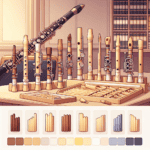Understanding Clarinets and Their Reeds
The clarinet's sound is both beautiful and complex, with each note contributing to the musical tapestry. The reed plays a crucial role in this process. Choosing the right reed isn't just about preference; it significantly impacts a clarinetist's playing style, tone, and overall performance.
The Different Types of Clarinets
While the Bb clarinet is commonly known, there's a wide variety of clarinets available. From the high-pitched Eb clarinet to the deep-toned bass clarinet, each type has unique characteristics that influence reed selection. Knowing these differences helps players pick reeds that complement their specific instrument.
Why Reeds Matter
A reed is like the heart of your clarinet. A good-quality reed can dramatically improve your sound, producing rich and full-bodied tones. Players often have different preferences – some opt for harder reeds for a bolder sound, while others choose softer reeds for easier playability. Trying out various strengths can lead to exciting discoveries in your playing!
| Reed Strength | Characteristics | Best For |
|---|---|---|
| Soft (1-2) | Easy to play, less resistance | Beginners, players with softer embouchures |
| Medium (2.5-3.5) | Balanced resistance and response | Intermediate players, versatile use |
| Hard (4-5) | More resistance, focused sound | Advanced players, strong embouchures |
The Most Popular Brands
Clarinetists often have favorite reed brands. Vandoren and Rico are well-known for their quality products. Martin Freres is another noteworthy brand. They're recognized for their skilled craftsmanship, offering reeds that add a personal touch to your playing. Their commitment to quality puts them among the top choices for many musicians.
Factors to Consider in Selection
1. Strength
Reed strength affects how easy it is to play and the sound produced. Softer reeds (typically strengths 1-2) are easier to play but might lack depth. Stronger reeds (strengths 4-5) offer more resistance and a more focused sound but can be harder for beginners to use effectively.
2. Material
Cane is the traditional material for clarinet reeds, prized for its warm tone and familiar feel. However, synthetic reeds are also available, offering consistent quality and longer lifespan.
3. Cut
The cut of a reed influences its response and sound characteristics. French-cut reeds often produce a refined sound, while American cuts tend to offer more volume and projection.
Maintaining Your Reeds
To get the most out of your reeds, follow these tips:
- Moisten your reed before playing to soften the cane and improve sound quality.
- When not in use, store reeds in a proper case to prevent damage.
- Use your reeds in rotation to allow each one time to dry out and maintain its shape.
Final Thoughts and Tips
Selecting the right reed is key to achieving the best sound from your clarinet. As you develop your own sound, exploring different reeds becomes an exciting journey of discovery. Don't be afraid to try various brands, lengths, and cuts, regardless of their cost. The improvement in sound quality and playability can be significant. Immerse yourself in the music, appreciate the unique qualities of your chosen reeds, and above all, savor every note you play on your Martin Freres clarinet.







